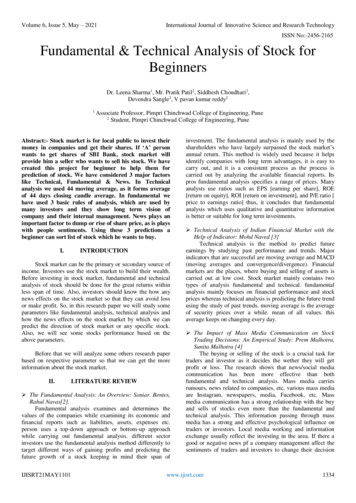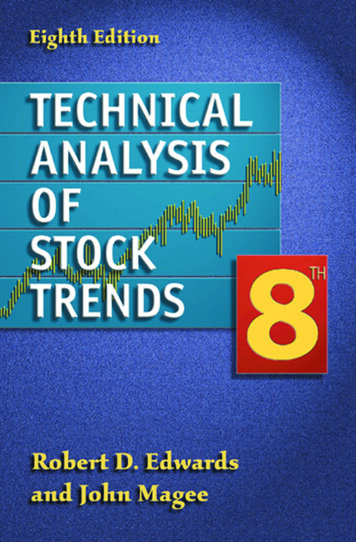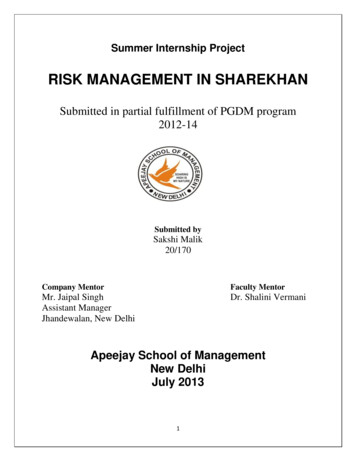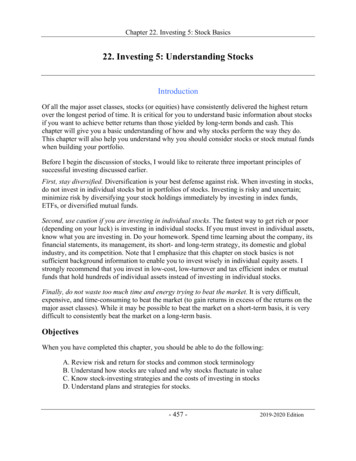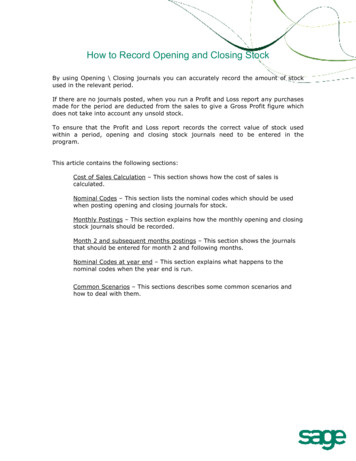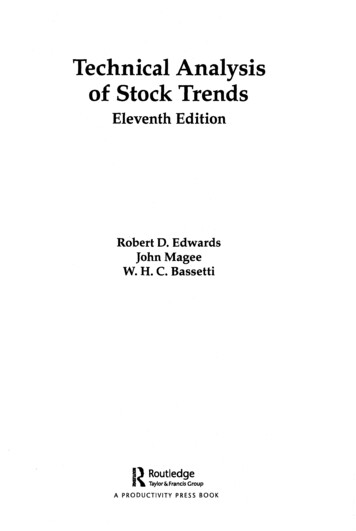
Transcription
Technical AnalysisofStock TrendsEleventh EditionRobert D. EdwardsJohn MageeW. H. C. BassettiJ Routledge% Taylor &Francis CroupA PRODUCTIVITY PRESS BOOK
ContentsPreface to the eleventh editionPreface to the tenth editionPreface to the ninth editionPreface to the eighth editionIn memoriamPreface to the seventh editionPreface to the fifth editionPreface to the fourth editionPreface to the second viiPart I: Technical theoryChapter 1 The technical approach to trading and investingDefinition of technical analysis34Chapter 2 ChartsDifferent types of scales78Chapter 3 The Dow TheoryThe Dow AveragesBasic tenetsTide, wave, and rippleMajor trend phasesPrinciple of confirmation111212141416Chapter 4 The Dow Theory's defectsThe Dow Theory is too lateThe Dow Theory is not infallibleThe Dow Theory frequently leaves the Investor in doubtThe Dow Theory does not help the Intermediate Trend investorThe Dow Theory in the 20th and 21st centuries212123232326Chapter 5 Replacing Dow Theory with John Magee's Basing points ProcedureThe fractal nature of the market3131vii
viiiContentsChapter 6 Important Reversal PattemsImportant Reversal PatternsTime required to reverse a trendThe Head-and-Shoulders Top FormationVolume is importantBreaking the necklineVariations in Head-and-Shoulders TopsPrice action following confirmation: the measuring formulaRelation of Head-and-Shoulders to Dow Theory414242444447495255Chapter 7 Important Reversal Patterns: continuedHead-and-Shoulders (EN: or Kilroy) BottomsMultiple Head-and-Shoulders PatternsTendency to symmetryA leisurely patternRounding Tops and BottomsHow Rounding Turns affect trading activityThe Dormant Bottom VariationVolume pattern at Tops575759616566707374Chapter 8 Important Reversal Patterns: the TrianglesSymmetrica! TrianglesSome cautions about Symmetrica!TrianglesHow prices break out of a Symmetrica! TriangleA typical Triangle developmentReversal or ConsolidationThe Right-Angle TrianglesA planned distributionDescending TrianglesVolume characteristics same as the Symmetrica! typeMeasuring implications of TrianglesTriangles on weekly and monthly chartsOther Triangulär formations77798288909497989899100100100Chapter 9 More important Reversal PatternsThe Rectangles, Double and Triple TopsPool OperationsRelation of rectangle to Dow LineRectangles from Right-Angle TrianglesDouble and Triple Tops and BottomsDistinguishing characteristicsDouble BottomsTriple Tops and Bottoms103103105112113113115118118Chapter 10 Other Reversal phenomenaThe Broadening FormationsVolume during Broadening FormationsA typical example121121122128
ContentsThe Orthodox Broadening TopWhy no Broadening Bottoms?Right-Angled Broadening FormationsThe DiamondWedge FormationsThe Falling WedgeWedges on weekly and monthly chartsRising Wedges common in Bear Market RailiesThe One-Day ReversalThe Selling ClimaxShort-term phenomena of potential importanceSpikesRunaway DaysKey Reversal hapter 11 Consolidation FormationsFlags and PennantsThe Pennant: a pointed PlagThe measuring formulaReliability of Flags and PennantsWhere they may be expectedPlag pictures on weekly and monthly chartsRectangular Consolidations: an early phase phenomenonHead-and-Shoulders ConsolidationsScallops: repeated SaucersModern versus old-style markets151151153154156157158159160162168Chapter 12 CapsWhich gaps are significant?Closing the gapEx-dividend gapsThe common or area gapBreakaway gapsContinuation or runaway gaps and the measuring ruleTwo or more runaway gapsExhaustion gapsThe Island ReversalGaps in the Averages.171171171174175177182184185186187Chapter 13 Support and ResistanceNormal trend developmentThe explanationEstimating Support-Resistance potentialLocating precise levelsSignificance of Support failurePopulär misconceptionsThe round figuresRepeating historical levels189190191193196197198200200
XContentsPattern ResistanceVolume on breaks through SupportSupport and Resistance in the Averages202205206Chapter 14 Trendlines and ChannelsThe TrendlineHow Trendlines are drawnArithmetic versus logarithmic scaleTests of authorityValidity of penetrationAmendment of TrendlinesDouble Trendlines and trend rangesTrend ChannelsExperimental LinesConsequences of Trendline penetration: ThrowbacksIntermediate DowntrendsCorrective trends: the Fan apter 15 Major TrendlinesMajor DowntrendsMajor Trend ChannelsTrendlines in the AveragesTrading the Averages in the 21st Century229242242243244Chapter 16 Technical analysis of commodity chartsTechnical analysis of commodity Charts, part 2: a 21st-century perspectiveRocket scientistsTurtles?The application of Edwards and Magee's methods to 21st-century futures marketsStopsA variety of methodsEverything you need to know as a chart analyst trading futures245249249250252258259259Chapter 17 A summary and concluding commentsTechnical analysis and technology in the 21st Century: the Computer and theinternet: tools of the investment/information revolutionThe importance of Computer technologySummary 1Other technological developments of importance to the technical Magee analystand all InvestorsThe Internet: the eighth wonder of the modern World (EN9: Appendix B,Resources, for the ninth edition has been enormously expanded and is ofparamount importance to modern investors.)Marking-to-marketSeparating the wheat from the chaffChaffSummary 2Advancements in investment technology, part 1: developments in finance theoryand practice261265267268268268269270270270271
ContentsOptionsQuantitative analysisOptions pricing models and their importanceFutures on IndexesOptions on futures and IndexesModern Portfolio TheoryThe wonders and joys of Investment technologyAdvancements in investment technology, part 2: futures and options on futures onthe Dow-Jones Industrial Index at the CBOTInvestment and hedging strategies using the CBOT DJIASM futures contractSettlement of futures contractsMarking-to-marketFungibilityDifferences between cash and futuresDow Index futuresUsing stock index futures to control exposure to the marketInvestment uses of Dow Index futuresSituation 1: Portfolio protectionSituation 2: Increasing exposure with futuresSituation 3: Using bond and index futures for asset allocationPerspectiveOptions on Dow Index futuresOption premiumsVolatilityExercising the OptionUsing futures options to participate in market movementsProfits in rising marketsExploiting market reversalsUsing puts to protect profits in an appreciated portfolioSituation 1Improving portfolio yieldsSituation 2Using option spreads in high- or low-volatility marketsSituation 3Situation 4PerspectiveRecommended further 286286287287287Part II: Trading tacticsChapter 18 The tactical problemStrategy and tactics for the long-term investor—What's a speculator? What's anInvestor?One definition of the long-term investorThe strategy of the long-term investorRhythmic investingSummary293297299299300302
xiiContentsChapter 19 The all-important detailsThe simplest and most direct way to use a Computer for charting analysisSummary303304305Chapter 20 The kind of Stocks we want: the speculator's viewpointThe kind of Stocks we want: the long-term investor's viewpointChanging opinions about conservative investingThe kinds of Stocks long-term Investors want: the long-term investor's viewpointConstruction of the Index Shares and similar InstrumentsAn outline of instruments available for trading and investingThe importance of these instruments: diversification, dampened risks, tax, andtechnical regularitySummary307310310311311312Chapter 21 Selection of Stocks to chart315Chapter 22 Selection of Stocks to chart: continued319Chapter 23 Choosing and managing high-risk Stocks: tulip Stocks, Internetsector, and speculative frenziesManaging tulipomanias and Internet frenzies and.BitcoinDetailed techniques for management of the runaway issuesHope Springs eternal and there is one born every second325326328332Chapter 24 The probable moves of your Stocks341Chapter 25 Two touchy questionsThe use of marginShort selling345345346Chapter 26 Round lots or odd lots?351Chapter 27 Stop OrdersThe progressive stopStop Systems and methodsA brief survey of stop methodsSome other stop methodsAverage True RangeParabolic stop and reverseTarget stopsA natural method used by the Turtles353355357358358358359359359Chapter 28 What is a Bottom and what is a Top?Basing PointsBasing Points: a case analyzedThe Basing Points paradigmKey to Figure 28.2 analysisA narrative of the events in the chart361362364365366367313313
ContentsxiiiThe complete Basing Points Procedura: taking into consideration the setting ofBasing Points on both wave lows and new highsThe complete Basing Points proceduraTwo Charts giving a long-view perspective on the complete (Variant 2) proceduraThe repräsentative case fully analyzed using wave lows and new highsA narrative of the events in the chart368369370370371Chapter 29 Trendlines in actionBuying stock, "going long"Liquidating, or selling a long positionSelling stock shortCovering short salesAdditional suggestionsGeneral outline of policy for trading in the Major Trend373375378379379380380Chapter 30 Use of Support and Resistance383Chapter 31 Not all in one basketEN: diversification and costs389390Chapter 32 Measuring implications in technical chart patterns391Chapter 33 Tactical review of chart actionThe Dow TheoryHead-and-Shoulders TopHead-and-Shoulders BottomComplex or multiple Head-and-ShouldersRounding Tops and BottomsSymmetrica! TrianglesRight-Angle TrianglesBroadening TopsRectanglesDouble Tops and BottomsRight-Angled Broadening FormationsThe DiamondWedgesOne-Day ReversaisFlags and PennantsCapsSupport and 409409409409410410411414414Chapter 34 A quick summation of tactical methodsGet out of present commitmentsMake new commitments417417418Chapter 35 Effect of technical trading on market action419
xivContentsChapter 36 Automated trendline: the Moving AverageSensitizing Moving AveragesCrossovers and penetrationsThe PENTAD Moving Average System from Formula Research421422422424Chapter 37 The same old patternsNot all the same427428Chapter 38 Balanced and diversifiedSeptember 28,1985: an oversold market481486Chapter 39 Trial and error487Chapter 40 How much capital to use in trading489Chapter 41 Application of capital in practicePut and call options491493Chapter 42 Portfolio risk managementOvertrading: a paradoxRisk of a Single stockRisk of a portfolioEN9: Risk and trendValue-at-Risk proceduraPragmatic Portfolio Theory (and practice)Pragmatic portfolio risk measurementDetermining the risk of one stockDetermining the risk for a portfolioMeasuring maximum drawdown (maximum retracement)Pragmatic portfolio analysis: measuring the riskPortfolio Ordinary or Operational RiskPortfolio risk over timePortfolio extraordinary or catastrophic riskControlling the RiskSummary of Risk and Money Management ProceduresInfinitely more sophisticated risk and money management procedures—RalphVince and optimal 03Chapter 43 Stick to your guns505Appendix A: The Dow Theory in practiceAppendix B: ResourcesAppendix C: Technical Analysis: beyond Edwards & MageeList of Illustrations and Text DiagramsAlphabetic Index of Stock 21623504
Preface to the eighth edition xxv In memoriam xxxv Preface to the seventh edition xxxvii Preface to the fifth edition xli Preface to the fourth edition xliii Preface to the second edition xlv Foreword xlvii Part I: Technical theory Chapter 1 The technical approach to trading and investing 3 Definition of technical analysis 4


